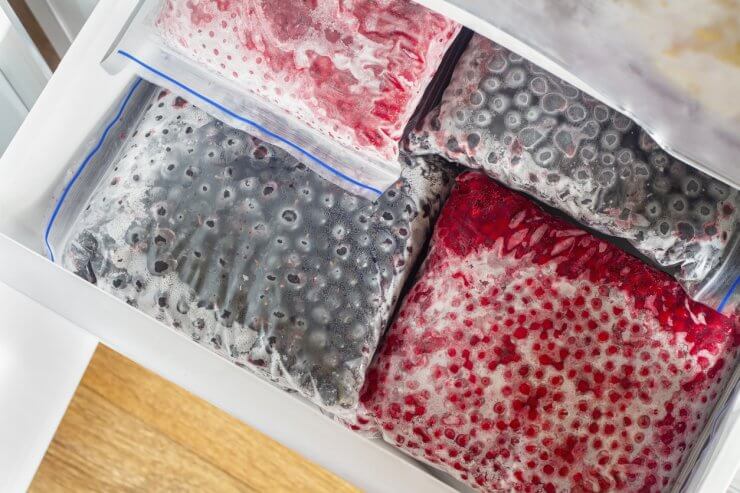
In the days before I knew the best way to freeze fruit and berries, I put around five pounds of fresh blueberries in my freezer. We had gone blueberry picking, and they were so perfectly plump and ripe that in seemingly no time, there were more blueberries than I knew what to do with.
Look, I love fresh blueberries. But there are only so many blueberry smoothies and blueberry pancakes and blueberry muffins you can make and eat before those fresh blueberries start going bad. I don’t know if you’ve ever frozen blueberries or other fruit, but in case you haven’t, don’t do what I did!
We’ve all gone to the grocery store and bought a bag of frozen blueberries, so I assumed if I just put my fresh blueberries into a freezer bag, they would freeze, and I could have local blueberries well into winter. Little did I realize that as the moisture in the blueberries froze, all of those plump little fruits would freeze together.
That would be cool if I were trying to create a gigantic blueberry ice cube. But that’s not what I was trying to do. I had a mess. And in case you’re wondering, they did eventually thaw, but it truly was a mushy mess of squishy berries. This leads me to share what I learned about the best way to freeze fruit.
Discover 7 top tips for growing, harvesting, and enjoying tomatoes from your home garden—when you access the FREE guide The Best Way to Grow Tomatoes, right now!

Discover the best way to freeze fruit and berries so you can plan ahead for baking
One of the keys to keeping that fresh flavor is to freeze your fruit as soon as possible after you harvest it. Another important component is to use a proper container. Look for something with an airtight lid that will hold up to freezing. Ziploc-style freezer bags work, as well.
As for freezing, there’s more than one best way to freeze fruit and berries, and it depends on what those fruits and berries are. I’ll get to the specifics in a moment, but one thing I’ve found helpful is to prepare fruits as I would use them. So I might peel and slice apples. Peaches, I might just slice. I would leave blueberries whole, and strawberries could go either way. I’d suggest slicing larger strawberries into halves or quarters. Again, prepping them however it is I would typically use them makes them easier to work with whenever I’m ready to thaw them and cook!
Now then, freezing smaller fruits like blueberries, raspberries, and blackberries is nice and easy. Wash and dry your berries, then place them on a parchment-lined baking tray in a single layer. Place this in the freezer for a few hours until they are frozen, then pour them into your freezer container.
The best way to freeze fruit that’s a bit larger, like cantaloupe or watermelon, is to remove the fruit from the rind, then cut the fruit into small cubes. After that, it’s just like the berries: freeze it on a tray, then store it in a freezer-safe container.
Stone fruits, like cherries, plums, peaches, etc., require a slightly different approach. You’ll need to remove the pit, even with smaller fruits like cherries. I can’t vouch for this, but supposedly if you don’t remove the pit, you end up with bitter flavors in your frozen fruit. I do this since I wouldn’t be baking with the pit anyway, but I also don’t care to take the risk. Once the pit is removed, and your fruit is sliced, I’d be willing to bet you know what comes next. Freeze them for a few hours on a baking tray in a single layer, then store them in a container.
Lastly, the best way to freeze fruit with skins like apples and pears is to slice or cube them and proceed as you would with freezing any other fruits and berries. First, though, dip them in a bowl of water with a bit of lemon juice stirred in. This helps prevent them from browning. You can peel them if you want, or you can skip it and leave the peel on. That’s entirely your call.
That’s all there is to it. It turns out that the best way to freeze fruit and berries is pretty simple! If you can’t have fresh fruit all year round, this is the next best thing!
Have you found a way to freeze fruit and berries that works well? I’d love to hear about it.
Discover 7 top tips for growing, harvesting, and enjoying tomatoes from your home garden—when you access the FREE guide The Best Way to Grow Tomatoes, right now!





Great article. What I typically do for blueberries is rinse in colander, lay on single layer on non-terry cloth towel (or layers of Bounty), lightly blot with wadded paper towel, and then add to parchment paper on rimmed cookie sheet in single layer for flash freezing for a few hours.
Next, I label freezer bags with type of berry, date and quantity—typically 2 cups of berries. I find six freezer bags fit on a rimmed cookie sheet, spaced equally full of 1.5 to 2 cups of berries, with the ziploc section flapping over the berries. (Berries start to thaw if they’ve been flash frozen, so sometimes I skip that step—but I NEVER skip the measuring step, using my one cup measuring cup and a canning funnel to easily fill the bag, to not touch (and partially thaw) the flash frozen berries with my hands.
Once frozen flat on the metal tray, these six bags stack right on top of each other in my freezer.